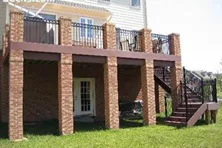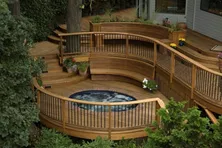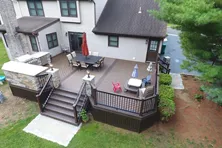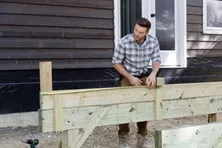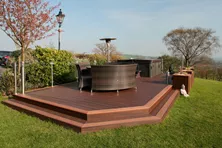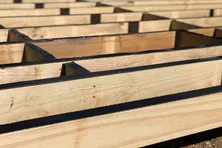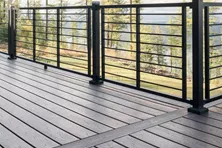How to Size a Deck Beam
A beam is a solid structural member that is supported by posts and footings that accepts and transfers the load from joists. Once you know the distance between support posts and the length of the joists that will be supported you can determine the required size by checking our beam-sizing chart. The size of a beam is a function of the amount of weight it must support and the distance it must span.
A common beam is composed of the same size and type of lumber used for the joists by nailing 2 or 3 together side by side. Even if you are allowed to use a smaller beam, you should maintain the same depth of material as the joists to present a uniform appearance. Never position your post “sandwiched” between two boards as is sometimes seen as a beam construction technique. The relationship between directly applied and fastened boards is what bonds the strength of a multiply beam.
Occasionally a beam application may require spanning a long distance that exceeds the design limits for conventional beams. In these cases you may have to use an engineered beam to meet the required load capacities. Engineered beams are fairly expensive, so you might want to add another post to reduce the span if possible. Your local building supplier should be capable to use your plans to determine which size and type of beam will work. Steel I beams are the strongest form of beam available and can be used to carry extremely long spans 20 ft + but are very expensive, heavy and difficult to work with.
How to Decorate Deck Support Columns
Browse some examples of decorative deck support posts for tall decks.
How to Slope a Deck for Water Runoff and Drainage
Learn if your deck needs to be sloped and how to do it.
Building a Round or Curved Deck
Learn how to build a curved deck using standard wood-framing materials. Composite decking material is more flexible for curved decks than wood.
Decking Patterns
Installing your decking at a 45-degree angle is a popular style for decks. This can be done to reduce decking seams or just for appearance.
Dos & Don'ts for Homeowners to Consider When Building a Deck
Your dream deck can take whatever shape you like. The trick is making it fit your budget and site conditions. While the deck doesn’t have to be built as a rectangle, there could be good reasons for doing just that.
Picture Frame Decking
Install a picture frame or perimeter board to finish the edge of your deck with style.
More Helpful Resources
Explore Articles by Topic

Footings
Information related to installing frost footings for decks

Framing
Learn structural framing methods

Decking
Learn about wood and composite decking materials

Stairs
An in-depth look at the complex issue of how to build stairs

Railings
How to install guardrails and handrails to meet IRC code

Features
An overview on water drainage, benches, planters and lights

Design
The basics of deck design

Planning
Learn about permits and working with contractors

Porches & Patios
Build a covered deck to enjoy all seasons

Ledger
Proper attachment techniques

Care
Maintain your deck to maintain your investment

Materials
An overview on water drainage, benches, planters and lights
Why is Joist Protection so Important for Your Deck?
If you’ve ever seen a piece of wood left out in the weather for any period of time, you know what happens: decay. Whether through wet rot, insect damage, or mildew, the fibers begin to break down.
How to Decorate Deck Support Columns
Browse some examples of decorative deck support posts for tall decks.
How to Connect a Notched Wood Post to a Beam
Learn how to install a notched wood support post to cantilevered beam connection using lag bolts, through bolts with washers or structural screws.
Building an Outdoor Space with James DeSantis
Composite decking can not be placed directly on concrete. But a substructure can solve for this. Explore this deck project with James DeSantis
Dos & Don'ts for Homeowners to Consider When Building a Deck
Your dream deck can take whatever shape you like. The trick is making it fit your budget and site conditions. While the deck doesn’t have to be built as a rectangle, there could be good reasons for doing just that.
6 Best Alternatives to Wooden Decking
While wood decking was previously considered the standard material for building a deck, that’s changed. Homeowners have been exploring and embracing different types of materials, and the availability of alternative decking materials has grown significantly.
Explore Articles by Topic

Footings
Information related to installing frost footings for decks

Framing
Learn structural framing methods

Decking
Learn about wood and composite decking materials

Stairs
An in-depth look at the complex issue of how to build stairs

Railings
How to install guardrails and handrails to meet IRC code

Features
An overview on water drainage, benches, planters and lights

Design
The basics of deck design

Planning
Learn about permits and working with contractors

Porches & Patios
Build a covered deck to enjoy all seasons

Ledger
Proper attachment techniques

Care
Maintain your deck to maintain your investment

Materials
An overview on water drainage, benches, planters and lights




